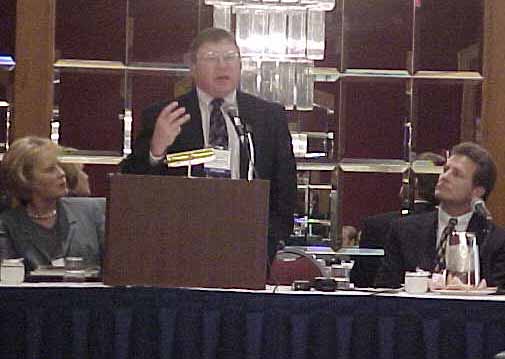E&EM doctoral candidate Jerry Sherk and E&EM professor Jonathan Deason made presentations at the national Brownfields conference held in the Adams Mark Hotel in Dallas, Texas during the period December 6-8, 1999. The presentations were made during the conference session on “Greening Brownfields: Protecting Greenspace and Cultivating Quality of Life,” Chaired by the Honorable Lee R. Clancey, Mayor of Cedar Rapids, Iowa and co-Chair of the U.S. Conference of Mayors. This session, which proved to be a popular one with the conference’s 3,000 attendees, included discussions on solutions to urban sprawl, greenspace protection, and financing of non-economic uses in brownfields redevelopment.
Reporter Thomas Horton of the Baltimore Sun interviews Jerry Sherk about GW's' Brownfields research project |
The GW presentations addressed the interim results yielded by the EPA-sponsored research project on brownfields redevelopment that is the subject of Jerry’s doctoral dissertation research. While the project has four major thrusts, most attendees were interested in the brownfields/greenfields trade-off ratios that are being derived in the research. These ratios indicated the degree to which the redevelopment of urban brownfield sites reduces developmental pressures on undisturbed, of “greenfield” sites.
Brownfields Redevelopment Pane - Standing L-R: GW's Jerry Sherk; Dr. Pablo Otaolo, Director General, Bilbao (Spain) Rio 2000 Exhibition; Reid Wilson, Chief of Staff, U.S. Environmental Protection Agency; and GW's Jon Deason; Seated L-R: Eileen Buckheit, Brownfields Project Manager, City of Bridgeport, Connecticut; and Lee R. Clancey, Mayor, Cedar Rapids, Iowa and Co-Chair, U.S. Conference of Mayors |
While the results presented were preliminary in nature, study results to date indicate that brownfield/greenfield trade-off ratios for industrial and manufacturing facilities raged from 1:0.64 to 1:3.28, with a mean of 1:1.60. For mixed industrial, manufacturing and commercial developments, the ratios ranged from 1:2.87 to 1:60.52, with a mean of 1:29.67. For residential and commercial developments the rations ranged from 1:12.21 to 1:35.7, with a mean of 1:21.54.
Dr. Deason and D.Sc. candidate Sherk discuss GW's Brownfields Project with EPA Assistant Administrator Tim Fields (center) |
These results were characterized as very preliminary estimates of the magnitude of reduced developmental pressures on previously undeveloped areas resulting from increased redevelopment of brownfield areas because a significant portion of the work remains to be performed.
Jon Deason and Jerry Sherk pose with Tiffany Cooper, EPA Program Manager for GW's brownfields project |
In addition to these key ratios, the researchers also explained that the research also is drawing important insights into the existence of federal policies that pose obstacles to brownfields redevelopment efforts, as well as the identification and evaluation of options to remove or reduce the effects of such obstacles. The research also is uncovering ways in which innovative land use policies and actions, particularly at the state and municipal levels, can enhance brownfields redevelopment efforts.
Some of the more than 3,000 participants who attended the Brownfields '99 Conference |
Deason and Sherk hope to have their work wrapped up and presented to EPA in a final report by the end of this summer.


